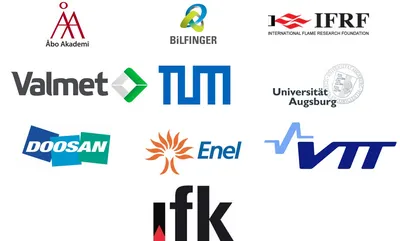EU Project: OnCord – Online corrosion monitoring for the combined combustion of coal and chlorine-rich biomasses in pulverised fuel and circulating fluidised bed systems

Motivation
Currently the conversion of large coal-fired boilers to 100% biomass and the co-firing of biomass with coal at elevated co-firing ratios, is practically limited to high grade wood materials because of the concerns about the potential negative impacts on the performance, reliability and integrity of the plant with the more difficult biomasses. For the same reasons, new build biomass boilers are generally designed with modest final steam conditions compared to those for coal. The principal limiting factors are the biomass fuel ash characteristics, and particularly the high alkali metal contents and the low sulphur to chlorine ratios.
The long-term objectives of much of the current developments in biomass firing and co-firing technologies are aimed at:
- The increased use of biomass, and particularly the low cost, low grade materials,
- Boiler operation at high live steam parameter, and
- Operation at high boiler availability and high power plant efficiency levels.
This will provide the greatest environmental benefits from the use of biomass at the lowest generation costs.
The more difficult biomasses such as straw and other agricultural residues, wood industry residues, demolition wood or herbaceous fast-growing energy crops can be made available in large quantities but are often avoided because of the concerns about excessive rates of ash deposition and of high temperature corrosion. The corrosion rates can be correlated to the chlorine content of the fuel and the deposition of alkali metal chlorides on boiler surfaces. Currently, project developers are tending to select high grade wood pellets as the biomass fuel, despite their high cost, because of the supply risks and technical risks associated with lower grade fuels.
The co-firing of coal or the use of coal ash as an additive can reduce the risks of excessive corrosion rates by:
- Increased sulphation of the ash deposits, i.e. reducing the levels of chlorides at the metal/deposit interfaces on high temperature surfaces, and
- The incorporation of the alkali metal species within the molten alumina-silicates in the fly ashes and within the deposits.
Goals
In the EU-project OnCord the use of coal and its inorganic constituents such as sulphur and alumina-silicates as a protective agent to prevent the formation of alkali metal chlorides, and consequently avoid chlorine-rich deposits, will be investigated at both laboratory/test rig and industrial scale. The basic chemical mechanisms are reasonably well understood but further research and demonstration at plant scale is needed, and this will require the use of state of the art, online corrosion monitoring equipment in a comprehensive way. The proposed online corrosion monitoring techniques will involve:
- Linear Polarisation Resistance method,
- Electrical Resistance method.
The project has a number of novel elements which will advance the current state of the art of high temperature corrosion monitoring and mitigation in a number of ways:
- The enabling of higher levels of fuel flexibility in biomass boilers and in biomass co-firing projects.
- The reduction of the risks of excessive metal loss by high temperature corrosion.
- The development of an operational strategy for boiler operators for the mitigation of corrosion when firing and co-firing difficult biomass materials.

